
















Spanish 84,054 German 60,935
Italian 46,949 Portuguese 37,628
Hebrew 36,135 French 1,033



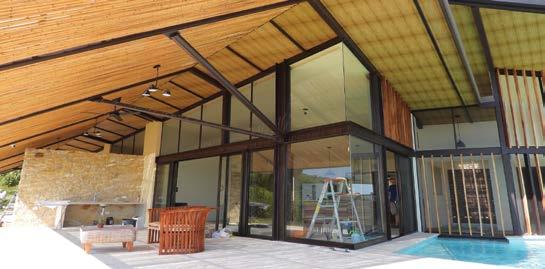


Those who live in Costa Rica, or have recently traveled here, have seen the increases in traffic and the rising prices of rent, food, and fuel. I hear people expressing shock at how expensive it is to live and travel here. I think many of the sources that tout inexpensive living in Costa Rica are not telling the actual truth, or are basing their claims on the less expensive areas away from the tourist beaches and other attractions.
by John Quam
As people continue to move here, are they making this a better place to live? Yes, probably for themselves and the future of the region. But initially, the impact of growth is not addressing the needs of the locals.
Gentrification of the area is stressing the locals in their living situations, as well as their daily sustenance. Many of the new hotels and businesses need employees to staff them and are finding themselves bringing in workers from as far as Liberia and Nicoya. This is due to the lack of affordable housing in these areas.
Generally, the cost of living increases would not be such a problem if salaries increased as well. But this has largely not been the case. Although the discrepancy is being addressed, pay rates have not caught up to what they should be yet.
Has the increase in foreigners moving here affected the country’s global “happiness index” standing? Costa Rica ranked in the top 10 for many years, but now, in the 2023 World Happiness Report, has slid to #23.
Impressive advertising initiatives promoting tourism in Costa Rica have been very effective. They’ve done a great job of enticing people here seeking a new life experience or finding a so-called “better place to live.” And they found Costa Rica.
Once you found Costa Rica did the pura vida lifestyle progress? Or has the light dimmed? What has caused this change?


Have you experienced those looks from the locals that seem to burn through you? I have many local Costa Rican friends and enjoy having discussions with them. However, I have seen and experienced the looks of detest directly focused on the “foreigner population.” It is quite uncomfortable. Generally, it comes from the older generation seeing their pura vida way of life being rerouted.
I kindly tread lightly around these people. Yet I am also engaging and friendly towards them — not ignoring them but also not being in their faces. I see many warm up as they realize that I am known and trusted in many of the places where such interactions occur. It is kind of fun to see the transformation, the next time I see the same locals and they greet me first.
So many comments are being made on social media about how friendly the Costa Ricans are. Do you really think they like you? Or, are they just tolerating you in sort of a business sense? I’m not referring to the true friendships that are made here between locals and expats. My comments here apply more to acquaintances who we loosely refer to as friends.
I have often made the statement that in Costa Rica, you will only have a few friends who are really friends, and many acquaintances. You will know these friends by their actions. That they care about your well being and you care about theirs shows true friendship.
When deciding to live in a foreign place, you are taking on an adventure that is not an easy one. The norm that we have been accustomed to in our home bases does not exist. We have to create our new normal by accepting our surroundings. We must strive to enhance, but not radically change, the way of life here.
Are you happy here?
John B. QuamThe Howler was in place way back in time, when there weren’t cafes with Internet, it was about 2008. There were 3 major companies in Tamarindo and we were one of them, so we published for advertising. We wanted to keep our name in the community and the magazine was the primary magazine at that time. We’ve been working together ever since, even now that we have our own Marketing Department.
We believe in our people, the people we manage. We believe in our staff. So, we didn’t stop during this season, we still had to be recognized as a company to the community. We didn’t stop paying and taking care of our employees because they had what was called essential work. They had to maintain the properties: fixing elevators, taking care of the swimming pools, housekeeping and so more.
We put our staff in 50% time and salary and then we also invested and bought essential food, we did that for 4 or 5 months. Every two weeks we had big piles of food coming in here and we gave it to everybody. It was all part of keeping essential normality to people.
There’s value in that momentum. Stopping and then popping up months later because the economy is good, to me, it doesn’t define a company with value. Being there and supporting your staff and being part of the community it does.
3.
The ads are all good sized. People see you there all the time and know that you are still in the market. We needed that exposure for people to know that we are still here.
We run medium size properties and that allow us to have better response times for people, for emergencies. I have staff that are very well trained to respond to any situation. We set the standard in our industry. So letting people know that through the advertising in the magazine is very important for us.
The Howler it’s well known and it’s good to be well known through it too.
 Why did you start marketing with Howler?
What value does providing the premium magazine with over 5 million readers in 2022 bring to you?
Why did you start marketing with Howler?
What value does providing the premium magazine with over 5 million readers in 2022 bring to you?
There’s some great content brewing in Howler’s April issue, starting with our cover story featuring Brothers of Ale Brewing in Guanacaste. We’re very excited to introduce a new magazine section shining a spotlight on Costa Rica’s fashion scene.
Join us in celebrating Playa Conchal’s No. 1 spot on EnjoyTravel.com’s annual “50 Best Beaches in the World” list. Be intrigued by the connection between Costa Rican birds and the planet’s geological history. Travel back in time to learn about the lost legacy of Costa Rica’s railroads. You’ll also find a memorial tribute to the legendary “King of Calypso” musician, Walter Ferguson. For readers with a green thumb, we offer tips from the Gringo Gardeners in Costa Rica Facebook group,



As Howler’s youngest-ever contributor, born in 2011, Marek Nahorski is also likely the youngest beekeeper in Costa Rica. We’re pleased to share the two-part story of how this came about — in Marek’s own words, along with his own photos — starting this month with “My Bee Farm Visit.”
The native of Szczecin, Poland showed signs of being multi-talented as a preschooler. “From the beginning,” his mom recalls, “he was a child who did not play with toys.” At the age of 4, Marek got his first DJ console and started playing concerts.
During the pandemic, he gave an interview on Polish breakfast television.
Soon after, Marek bravely accepted the move with his family to Costa Rica — a country so distant from his homeland. With virtually no knowledge of English or Spanish, he started attending school here. He opened a business with 3-D printers, and then used his earnings to buy vending machines. Next, he was able to fulfill another dream of having his own bee apiary. His family now looks forward to the first honey!
Andrea Chacón. Paralegal at GM Attorneys.
Ivan Granados. Managing Partner at GM Attorneys, specializing in real estate and corporate law. igranados@ gmattorneyscr.com
Karl Kahler. Author of "Frommer's Costa Rica 2017," former travel editor of the Tico Times and former national editor of California's San Jose Mercury News.
Jorge Arturo Mora. Writer, chronicler and cultural journalist. His texts have been published in the newspapers 'La Nación' of Costa Rica, 'El Tiempo' from Colombia, in the international magazine 'Relatto' and on the Rotten Tomatoes platform. He is the author of the novel 'El rainbow nest', published by Encino Ediciones.
Tom Schultz. BS Biology and Geology, avid birder and nature photographer, retired software executive. tom@ pananima.com
Photo cover of BOA ale samplesCourtesy of Brothers of Ale Brewing.Captain Paul Watson. Globally renowned ocean conservationist and environmental activist, advancing marine ecosystem protection initiatives through the new Captain Paul Watson Foundation. Co-founder of the Greenpeace Foundation and founder of the Sea Shepherd Conservation Society.
Dr. Herbert Weinman. MD, MBA. thedoctorisinsharkfm@ gmail.com
Helen Woodhouse. Soon after moving from Saskatoon, Saskatchewan to Quepos/ Manuel Antonio, founded the Facebook group Gringo Gardeners in Costa Rica, dedicated to gardening successes and challenges in this wonderfully diverse country.

Alejandro Zúñiga. Costa Ricabased journalist, traveler and content creator.
John B. Quam
executive director - Terry Carlile
account executive
Mary Fernández
Editorial Staff
Debbie Bride - Editorial Coordinator
Laurie Quam - Copy Editor
HOWLER (™) 2017
Cont act
John Quam - Managing Partner headmonkey@howlermag.com
Editor: editor@howlermag.com
Advertising: terry@howlermag.com
Design: design@howlermag.com
CR Office: (506) 4701-5942
Fred Lipsky. Retired New York police officer, now enjoying kayak fishing and nature photography adventures in Costa Rica.
Chalo. Published Beauty Fashion Photographer. Chalo was featured in Howler's "Through the Lens" edition.
• Artesano Architect and Design
• Bookstore of the Waves
• Force One Security
• GM Attorney
• Hidden Garden Art Gallery
• Horizon Pacific Rental Property
• Grupo Tropigala S.A.
• Jardin La Torre - a retirement community
• Liberty Express
• Mar Vista
• Odry's Massage
• Palmex
• Tres Amigos Realty Group
• The Coast
Howler Magazine Costa Rica @howlercostarica @thehowlermag @howlermagazine
The Howler Gold Coast CR S.A.
Ced. Juridica: 3-101-725213
The opinions, beliefs and viewpoints expressed by the various authors in this publication do not necessarily reflect the opinions, beliefs and viewpoints of Howler organization or its advertisers.
All rights reserved. No part of this publication may be reproduced, distributed, or transmitted in any form or by any means, including photocopying, recording, or other electronic or mechanical methods, without the prior written permission of the publisher, except in the case of brief quotations embodied in critical reviews and certain other noncommercial uses permitted by copyright law. For permission requests write to: info@howlermag.com.
The Howler Magazine does not assume responsibility for the content of its advertisements.
Images not credited are acquired from stock photography services.
Copyright © 2023
The Howler Gold Coast CR S.A
Copyright © 2023 Howler Media Holding, Inc. Panama

The Howler Gold Coast CR S.A.
Ced. Juridica: 3-101-725213
HOWLER (TM)2021
UP FRONT:
Brothers of Ale:
A Taste at What's On Tap
Editorial: Are You Happy Here?
REAL ESTATE
• Tuanis Sunset Realty
• Jardin La Torre
• Horizon Pacific
• Sun Real Estate
• Grupo Tropical
• Tres Amigos
TRAVEL & ADVENTURE
• New Heights of Excitement for 60 International Pilots
• Guanacaste Boasts Best Beach in the World!
• Birds of Gondwandaland
• My Bee Farm Visit
• The Long-Tailed Silky Flycatcher
PURA VIDA
• Gringo Gardeners in Costa Rica
• Our New War Against Whaling
• Vasomotor Rhinitis
• Tico Expressions
• The Lost Legacy of Costa Rica's Railroads
• In Memory of Walter Ferguson: The King of Calypso
• Artist Spotlight: Daniela Vargas Winiker
• MIles and Decades Apart

Click on the section to go directly to those pages.

• Fashion Festival April 21 & 22
• Underwater Fashion Photography by Chalo

• Designer: ZEJI
CR BUSINESS
• First All-Female Flight Crew International Women's Day
• New Urban and Rural Land
Use Category Proposed
• Top 3 Exports of Costa Rica
CR SURF
• Tide Chart, Sun, Moon Schedule
• Do You Collect Seashells?
Photo by Chalo
 by Howler Staff
by Howler Staff
Three years after opening its doors as Costa Rica’s newest premier craft brewery, Brothers Of Ale Brewing is being well-served by all the entrepreneurial ingredients it takes to grow and thrive: a clear vision, patience, determination, resilience and hard work. Add to that a steadfast commitment to high product quality and customer satisfaction, plus a passion for giving back, and this remarkable Guanacaste success story keeps unfolding.
We are pleased to provide more details in this month’s cover story, and to share these highlights of our conversation with Brothers of Ale founder Alaks Thompson.
In 2016, I was working in South America at the time and planning on the eventual Brothers Of Ale concept. I had been talking with my sister, who knew that I was leaning toward New Zealand and the Queenstown area, as I had such an unreal experience working and traveling in the country years before. However, my sister insisted I check out Costa Rica. At that time, it was scoring so high on the quality-of-life index.



With constant feedback and not settling for mediocrity, I think we have a pretty good stride.



• Great food selections
• Arts, concerts, family events



• Special television viewing parties
• Business meetings
• An exciting atmosphere
You may come as a stranger, but you'll leave as friends.
CLICK FOR MORE
So I did. I spent about three months based out of Tamarindo, but traveling around the country. Later on in 2016, I bought my house and made the full-time move.
"Costa Rica makes easy difficult and difficult easy." That phrase never rang so true as it did when I found myself moving here and living a full-time life. It's one thing to vacation here — everything is pura vida — but to live here and operate a business here, it takes patience and an understanding that you will not change Costa Rica — for the better or worse. Banks, government offices, utilities … you name it, they are infamous for long lines and not being well-organized. But it is in these challenges that the successful succeed.
I also found that surrounding yourself with similar-minded people, and those who may have gone through the same processes before you, allows you to surge ahead and not let any roadblocks keep you down.
When we opened at the start of COVID, our base was exclusively locals. I'd say that it took about a solid year of growing our reputation

before we really started seeing tourists come in. We aren't in downtown Tama or Potrero. So being a destination location, we had to hit our mark on quality and service, and I believe we are doing that. It's a continual process, but with constant feedback and not settling for mediocrity, I think we have a pretty good stride.
And our customer reviews and feedback have allowed exponentially more people to come and seek us out. We hear pretty often, "So-and-so told us to come here and I'm so happy we did!"
So word of mouth has allowed more locals and tourists to come check us out. Right now I'd say we are about 70% locals and 30% tourists.




Alaks was 3,500+ miles away on a snowboarding trip in the mountains of Utah (Snowbasin, January 2023).
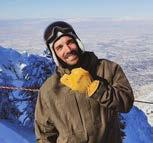
Of the 11 total lifts (and hundreds of chairlifts) that he could have sat in, he sat in this one: ONE WITH A @brothersofale STICKER ON IT!!
Unbelievable moment and what it’s all about! Thank you for spreading the BOA love! (But seriously, who did this? You rock, and next round is on us.)
Why is it Important to Work with a Licensed Real Estate Agent and a Long Standing Real Estate Company?

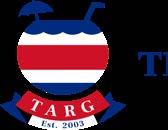



Buying Real Estate? The Basics
What our Reasons Why Love Living Here?
How Do People Enjoy Life Here? CLICK OR
What are our 99 Reasons Why We Living Here?
Are Real Estate Agents Licensed in Costa Rica?





CLICK YOUR QUESTION OR HERE FOR MORE SOLUTIONS:

• Every 11 minutes there is a crime in Costa Rica
• Rainy Season Forecast
• Medical devices,pineapples and bananas were the most exported products in 2022
• Lower gasoline prices on the way
• International airport in the South Zone would take tourism to another level
• Study reveals that 80% of Costa Rican women do not like debts
• Why expanding Businesses should invest in marketing automation tools
• Television series described Costa Rica as a dirty country full of homeless people
• Accessible parking spaces - who can use them?
• MOPT extends, again, vehicle inspections deadlines

• Online casinos
• Costa Rica signs regulartions to the law to attract film investments
• Rodrigo Chaves' managerial style: if you don't meet goals, you better leave
• Prosecutor requests 255 years in prison against accused of murdering Dr. Maria Lisa Cedeno




The Costa Rican Fashion Festival (FCRModa) is an event that aims to position and serve as a showcase for Costa Rican fashion designers and national textile brands, both at the level of the media, potential buyers and the open public.
It consists of two days of fashion shows (Friday, April 21 7 p.m. and Saturday, April 22, 3 p.m. and 7 p.m.
The fashion event in Costa Rica has a program of talks, training and workshops by specialists from the INA, Ministry of Industry and Commerce MEIC, and its director Juan José Jiménez.
The activity will take place at the Barceló San José Hotel in downtown San José, due to its magnificent conditions and facilities and easy access to said space. It is also a beautiful place with beautiful gardens and facilities.
The designers who are featured:
• Kasandra Farrier
• Secu Textile
• Terra Firme
• SE Clothes
• 4 Elements
• Hieronymus
• Mario Lynx
• Abelardo Castini
• Joy by Amanda
• Michelle Morgan
• Red Point
• Prolific Quarterly
Apart from having a of great Costa Rican designers, the event has also invited some international designers that there is feedback what the clothing industry and its players do in countries. Among the international designers we have the famous prominent Mexican Aline Moreno, Panama be represented by Rolando Torres, from Chile Isabel Ramírez and other designers soon to be presented.
More Informationa list Rican some designers so feedback on industry other the designers famous and designer Panama will Rolando Isabel designers presented.

 Howler Staff by Chalo
Howler Staff by Chalo
This underwater fashion photography session turned out to be a great challenge for everyone, but with a small great professional production team, very good results were achieved. The editorial Aire y Agua was divided into two parts. Aerial shots were taken with a drone looking towards the water, where the model literally posed floating on the water. The control of our muses to achieve this was incredible.
The interesting thing about this part of the editorial is its perspectives: they are unusual but with a very artistic and different touch. To take the shots, a drone was used. The challenge of this part of the stage was the wind, and keeping the frame with the model, which was on the moving water, was difficult but entertaining.



The hardest aspect of this part of the editorial was conquered by Luzmery, the model, because it was quite a process. First, accustoming her body to the temperature of the water, then accustoming her wet face and hair to be able to achieve natural expressions, I think, were the most difficult thing about posing on top of the water. You have no idea, is it floating, but at the same time posing? Nothing simple, but the light came. The model floated and began to pose fashionably on the water, calmly and decisively; this made for a nice final job. Thanks for the effort, Luzmery!





Underwater or underwater fashion photography is not a very common art, but it is very impressive. The result is very beautiful, but that takes a lot of effort and preparation from both the photographer and the model. Everything has to be well planned in advance. It is very important to know how to communicate underwater with gestures. Each shot is performed in an apnea (a single inspiration until the shots are finished).
I love being creative and the ability to be unique.

The equipment used, the concentration underwater, the lighting, the vision... All these elements form a set that must come together correctly in order to capture those fashionable moments underwater.
 Photo: Chalo García Model: Luzmery Rodriguez
Photo: Chalo García Model: Luzmery Rodriguez
Mattia Masanes
Photographer: Fabián Moreaux
Makeup: EkaMakeuplooks
Zejí is a textile proposal that was born in 2009 with of offering creative and innovative pieces as creative process based on textures, colors, shapes trends in the world of fashion to achieve an exclusive, design adapted to clients who are mainly men.

We are a brand that works in artistic entrepreneurship, is why we develop hand in hand with the cultural country as costume designers for dance and mixing various techniques that interweave theatricality daily life.
See More Fashion


Model: Douglas Castillo
Photographer: Fabián Moreaux
Makeup: EkaMakeuplooks
Model: Esteban Castillo
Photographer: Fabián
Makeup: EkaMakeuplooks
with the vision a result of a shapes and current exclusive, modern men. entrepreneurship, which cultural sector of the theater works, theatricality with

Fabián Moreaux

EkaMakeuplooks
Makeup: EkaMakeuplooks
Castillo Douglas Castillo and Esteban Castillo Photographer: Fabián Moreaux

The best thing we ever did was buy property in the Guanacaste Region (specifically in Playa Coco). We are still US citizens but living as residents of this beautiful country.
Why move to Costa Rica you might ask? Well besides being a tropical paradise, the cost of living is much less than in the US. You can escape the crazy fast-paced way of life you’re used to and find a slower peaceful lifestyle.
The amenities here are much of what you are used to. It’s a safe place to live and work. We can be your local experts in all the areas you might find of interest to live in such as the beach towns of Panama, Hermosa, Coco, Ocotal, Flamingo, Sardinal, and Tamarindo. We want to be your Concierge to live your best life in Costa Rica.
Here's our stories:
Hola, amigos, I’m Ron Morrell. My Story has had plenty of loops and rolls over the years but I can honestly say that I’ve found the last place I want to call home. I started out in a rather small town in Michigan but made sure I had a way out as soon as I was educated enough to find my way around the world. Part two of my schooling was at the United States Air Force Academy which put me on a track that can never be repeated.
My days after the Academy turned into spending time strapped into a single-seat attack aircraft named the “Warthog”. I did my best to be the best and trained to make my jet an extension of myself and my team. Those days were exhilarating, tense, exciting and sometimes completely beyond my earlier comprehension. But alas, being a fighter pilot becomes a young man’s game and I had to figure out how to grow up and create a long-term career. The decision time finally came, and I found the call of a civilian flying career becoming pretty loud.
I'm Molly, people often ask: How did I get to Costa Rica? Well, my life story was fairly average. I was born and raised in southern Minnesota, started my career out of college with a nursing degree, and then found my real passion was real estate. Raising my children while working in real estate was such a blessing for the flexibility it offered. During those 27+ years of real estate, I attended different conventions and conferences, and it was at one of those real estate conventions, I met a fellow colleague in Seattle. Over the years we stayed in touch sporadically, and only saw each other at an

occasional event. Now fast forward to 2022, it had been 5 years since we last saw each other, and the only communication was a couple of birthday text messages over the years. He had owned a place in Playas Del Coco for a few years, so I finally booked a flight to experience a Costa Rica vacation for the first time. I was so excited to see this beautiful country and spend time getting to know all the awesome sights and people. Now in hindsight, that little vacation to Costa Rica has since changed my life forever! That friend and colleague is now my best friend and life partner as we are engaged to be married June 2023.
Never could I have imagined my life path would change so drastically. I’m now living the Pura Vida life here in Costa Rica. I brought my passion for real estate with me and so it was a natural transition to join Tres Amigos Realty Group and help others find their little piece of paradise. I absolutely love what I do!





CLICK HERE TO JOIN

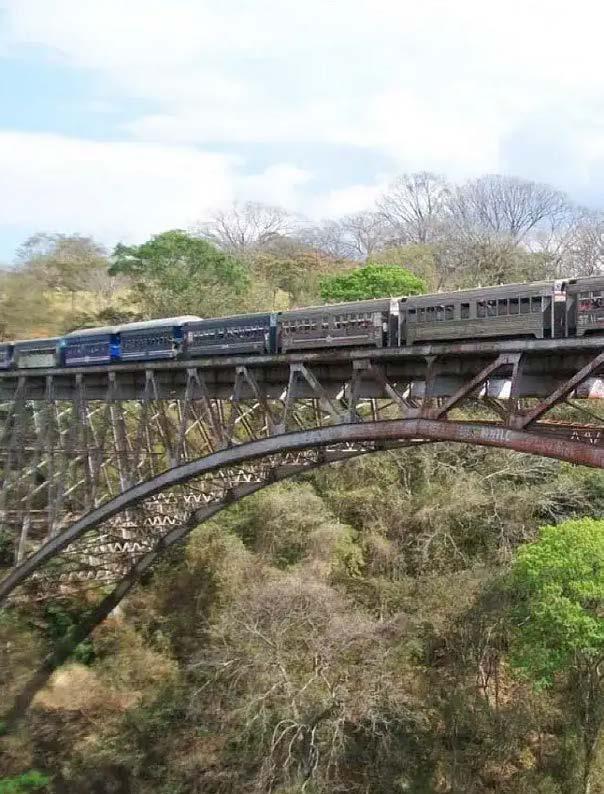 by Alejandro Zúñiga
by Alejandro Zúñiga
The railroad project itself — meant to facilitate coffee exports — was an abject disaster.

One could argue that Costa Rica’s railroads birthed modern-day Central America.
In the late 1800s, U.S. entrepreneur Henry Meigs signed a contract with the Costa Rican government to build a railroad from San José to the Caribbean. When Meigs died in 1877, his nephew, Minor Cooper Keith, took over the project.
The railroad project itself — meant to facilitate coffee exports — was an abject disaster. Malaria, yellow fever and other tropical diseases killed thousands of workers, and the line wasn’t finished until 1890. In the process, Costa Rica defaulted on its payments and instead compensated Keith with 800,000 acres of tax-free land.
Keith, ever the entrepreneur, began planting bananas on his newfound Costa Rican land and exporting the tropical fruit to the United States. The banana trade made him enormously wealthy, and he soon grew his empire across Central America and Colombia.
Eventually, Keith merged his enterprise with the Boston Fruit Company to form the United Fruit Company (now known as Chiquita). Over the next seven decades, United Fruit expanded its land ownership and workforce, strongarming governments1 into favorable treatment to preserve its lucrative monopoly.
The development of many Central American countries (the so-called “banana republics”) is inextricably linked to United Fruit.
And it all started with a railroad in Costa Rica.
Keith’s railroad in Costa Rica operated as a for-profit business, so it didn’t meet the country’s needs for passenger travel and coffee exports.
In 1897, Costa Rica commissioned a competing project — a railroad from San José to the Pacific port of Puntarenas. By 1907, the country had completed tracks to Orotina but had run out of money; this forced travelers and transporters to use oxcarts for the final stretch.

Two Spanish visitors described the oxcart journey from Orotina to the Pacific Ocean as “four deadly hours” under a merciless sun that threatened “suffocation in the dust.”
In an effort not to kill any weary Spaniards, Costa Rica finished the full route from San José to the Pacific Ocean in 1910.
Over the following decades, Costa Rica modernized and improved its railroads, which were a source of national pride. The biggest advance came in 1932, when the country inaugurated an electric railroad to the Pacific.
With its railroads, Costa Rica established itself in the international market through its coffee exports. And in the process, the railroads provided fast, safe and cheap transport from the capital to the coasts, helping to stimulate growth outside of the cities.
Towns were formed along the Pacific railroad, and agriculture projects expanded near the route. Puntarenas developed into a small city, and areas as far away as the Nicoya Peninsula suddenly had stronger economic and cultural ties to San José.

“Undoubtedly, the symbol of Costa Rican progress was embodied in the Pacific Railroad, a purely state institution that emerged at a key moment in the history of Costa Rica,” wrote the University of Costa Rica’s (UCR) Javier Agüero García.

By the 1990s, Costa Rica’s railroads were in rough shape. An analysis from the UCR noted the Costa Rican Railway Institute (INCOFER) was an agency in “permanent crisis.”
Public domain photographs
 1895 period old photo
The Río Grande bridge as it appeared in the early 1900s.
video
ca.1895
The thick jungle.
1895 period old photo
The Río Grande bridge as it appeared in the early 1900s.
video
ca.1895
The thick jungle.


“King of Calypso” Passes Away at Age 103
With his raspy, gravelly tone, he took care to build a soundscape of the Costa Rican Caribbean.
 by Jorge Arturo Mora
photo by Nathalie Vigini
by Jorge Arturo Mora
photo by Nathalie Vigini
How can know so much about someone you've never met? The answer, surely, will be that there are people who seem to have fallen from astrolites — humans who seem to have an aura and a talent that radiates from the invisible.
I remember the first time I embraced the dream of meeting Don Walter Ferguson, widely known as “Mr. Gavitt.” In those times, about 10 years ago, the journalist Diego Delfino had uploaded on his Facebook page a tremendously casual image of himself with the legendary musician. It had the aura of a postcard. It was unique: he was there in the photo next to an absolute legend.
Over the years, my desire to meet Mr. Gavitt grew, but there were limitations, including the distance to his residence in Cahuita. In addition, it would be an arduous task finding a form of contact that would allow a literal stranger to shake hands with such an eminence.
I still did not lose faith. I devoted myself to listening to Ferguson’s music during those years, trying to study it. I sought to find out how a calypso benchmark was made and, in the long run, a legend of Costa Rican creative inventiveness.
When I joined the newspaper La Nación as a head journalist for arts and culture, I once again dreamed of that chance to meet the music icon. One of my colleagues, Carlos Soto, was the owner of the music source and managed to visit Ferguson on the occasion of the Magón Prize being awarded to him in 2018.
Envy appeared — the good kind of envy … Carlos knows it well. What a chance he had! Deep inside of me, I supposed that this was my last chance for a “meeting” with the musician, even if channeled through someone else. I was not mistaken; I could never know Walter Ferguson in person. But the satisfaction with what my colleague told me about the interview was so valuable that I still cling to his words as if it had been a meeting from another dimension.
“My mom used to tell me that I was going to be a great composer,” Ferguson told Carlos. This recollection offered precious further evidence for the theory that Mr. Gavitt (who, by the way, was born in Panama) was an astrolith.
My colleague Carlos told me that the living room in Don Walter's house was always filled with foreigners. It was no wonder that every time there was a festival in the Caribbean, Ferguson was the dedicated one. Such news caused many international visitors (and of course, Costa Ricans) to show up in the living room of his home to ask him “things” about his songs and express their admiration for him.
Ferguson claims to have composed more than 150 songs, although he only recorded about 40 — more than enough testimony to notice his verve. With his raspy, gravelly tone, he took care Caribbean.
Wata,” “Callaloo,” “Carnaval Day” and many other songs portraying life in the villages of the

Photos courtesy of Facebook Group: Fotografias Antiguas Indígenas de Costa Rica- CLICK HERE
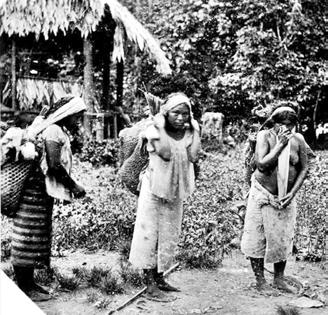

Talamanca, 1912. Located in the extreme southeast of the province of Limón, this canton today has the highest percentage of land under some kind of protection.
Construction of la Plaza de la Cultura in San José, early 1970s

Howler’s Artist Spotlight series called "Making a Scene" is back this month featuring Costa Rican artist Daniela Vargas Winiker. "My purpose is to combine painting, sculpture and installation, achieving interactive spaces where the sensory experience can captivate the viewer so that they can enter my magical world," says Daniela. "I paint butterflies as though they are a community made up of a multitude of individual beings, as a whole, together, in flocks, in flight, butterflies by day, at sunset, and within an infinite number of scenarios of my imagination."
1We all have wings to reach different paths. The representation of the butterflies on the canvas, as well as on the sphere, allows the viewer to feel that the butterflies transcend. They leave the canvas and continue their flight towards another plane. It is about creating a sensation where the two-dimensional proposal comes to life and continuity is given to the work through the use of other materials.
2Monarch butterflies represent a symbol of constant transformation, from egg to caterpillar, to chrysalis, and finally to butterfly. They are synonymous with perseverance that is reflected in the thousands of kilometers they travel until they achieve their goal.
3
More than beauty, color and joy, butterflies represent life; gestation, transformation, strength and departure.

4The morpho butterfly has been the subject of legends and a multitude of studies, due to its particular characteristics. It is said that blue butterflies have a certain mysticism, given the popular belief that seeing one gives you luck. They are characterized by their large size and striking blue color, but they are not actually blue. It is the reflection of light on microscopic scales of the wings — a phenomenon known as structural coloration.

"Monarch butterflies represent a symbol of constant transformation"1 Esfera Espejo de Vida (Mirror of Life Sphere) Resin powder and silver foil varnish, 25cm 3 Mariposas (Butterflies) Series of 3 oil paintings, each 9" x 9.5"


 2 La Gran Viajera — la Mariposa Monarca (The Great Traveler — the Monarch Butterfly) Oil, 20" x 34"
Photos courtesy of Hidden Garden Art Gallery
2 La Gran Viajera — la Mariposa Monarca (The Great Traveler — the Monarch Butterfly) Oil, 20" x 34"
Photos courtesy of Hidden Garden Art Gallery

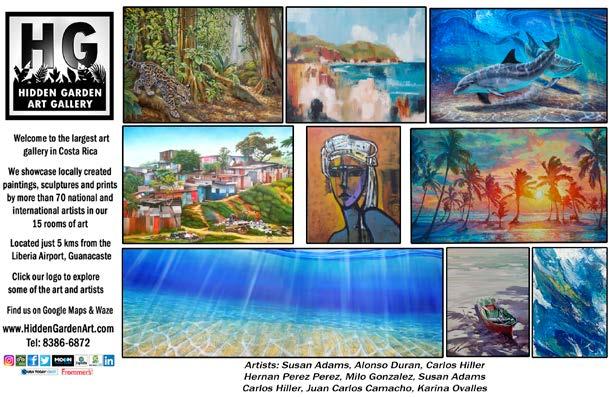
My wife, Caryl, and I, retired US military, spent our first military assignment, in the 1970s, at Fort Gulick, the Caribbean side of Panama. Native Illinoisans, we learned to love all the tropics had to offer — although we never really adapted to the heat. At the end of our tour, we drove back to the States from Panama — a 10-day trek. We drove through most of the Central American countries, but only one really impressed us. We agreed that Costa Rica would be worth another visit. We didn’t realize that we would be driving within two miles of where we’ve been settled in Costa Rica for the past 12 years.
It took us 37 years to get back to Costa Rica — even for a visit. Life got in the way. In February 2011, we finally found time for a threeday tour to view retired life in Costa Rica. During the two years prior to our visit, we traveled to all the retirement states of the union, including Hawaii, but couldn’t find what we were looking for — a year-round temperate climate, an easy pace of life, a pastoral setting with views, with access to a major city. In all fairness, parts of Hawaii offered these but it was just too far from the US mainland.
The tour guide for our visit was George Lundquist, now retired, who went out of his way to show us the good, the bad, and the ugly of retired Costa Rica and various parts of Costa Rica. We visited with expats who had lived here for a couple to many years and got their valuable input. In addition to recommendations of where and where not to live, we had our own preferences. For us, the coast was too hot, San José was too busy, and much of the country was too far away from San José’s major medical facilities—not needed then or currently, but high on our “must-have” list.









The Long-tailed Silky Flycatcher (Ptilogonys caudatus)
• Related to waxwings, and have in common a soft, silky plumage
• Found only in the mountains of Costa Rica and western Panama, usually from 1,850 meters altitude to the timberline
• Often perch prominently on high exposed twigs
• Male is thrush-sized, with pale gray forehead; yellow crested head, neck, throat and yellow belly; blue-gray back, lower breast and upper belly and black flight and tail feathers
• Female is generally duller in color, with a darker gray forehead, olive body plumage and a shorter, duller black tail
• Forages in small flocks when not breeding, flycatching for small insects or taking small fruits — especially mistletoe — berries and vegetables
• The only known bird species with a specialized gizzard mechanism that removes berry skins and separates for more efficient digestion
• Breeding pairs in mountain forest habitat build lichen cup nest high in a tree, sometimes in loose colonies, for spring nesting
• Both male and female participate in the 15-day incubation of two brown and lilac-blotched gray eggs
• The young fledge 18 to 25 days after hatching, and are fed by both parents
• Known for imitating the calls of 12 other bird species
Source: Beauty of Birds
Each month we'll highlight one of Fred's amazing bird photographs. Click lower right for more information. Complete the
Photographed in December 2022 at a high elevation in the mountains south of Cartago, Costa Rica.

puzzle



Howler is delighted to feature this first-hand account of an 11-year-old’s journey in Costa Rica learning about bees. Part 1 of the young author’s two-part story takes place at a bee farm, where everything about his perspective changed. This was the inspiration behind the colony he is now starting on his own at his family home.
Owww! A bee stung me! A bee — what did I do to it? Bees usually are nice. But I was collecting honey from the beehive, when sometimes they get mad. But if a bee would not sting me I would not be a beekeeper.
Two months earlier, I got invited to a bee farm. That’s when things changed. They changed a lot. I saw how smart bees are and how they have something to do all the time. So let me explain what they have to do.
The queen bee is responsible for laying eggs, and her pheromones dictate the behavior of the rest of the colony. The drones are male bees that exist solely to mate with the queen bee. They do not have stingers and do not gather food. The workers are female bees that do most of the work in the colony. They are responsible for tasks such as collecting nectar and pollen, building the hive, and caring for the young. Workers have a specialized body part called a pollen basket that they use to carry pollen back to the hive.
When a worker bee finds a source of nectar, she returns to the hive and does a "dance" that tells the other bees where to find the food.
This dance is called the waggle dance, and it communicates the direction and distance of the food source.
Bees are also important pollinators, and they play a crucial role in the ecosystem by helping plants to reproduce. When a bee lands on a flower to collect nectar, it picks up pollen on its body and transfers it to the next flower it visits. This process of pollination helps to fertilize the flowers and ensure that they can produce seeds and fruit.
Overall, bees work together in a highly organized and efficient way to ensure the survival and success of their colony.


So now you know bees always have work. But the most important thing I experienced is this: if you are scared when working with bees your body will release certain pheromones, which bees can detect as a threat.
Stay tuned for the rest of my bee story in a future Howler issue.
I saw how smart bees are and how they have something to do all the time.




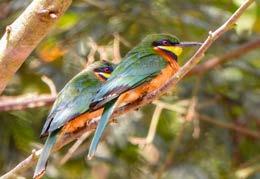

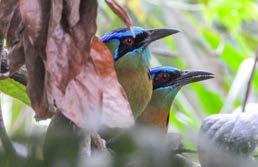
Next time you are at a bird feeder in Costa Rica, or walking in the jungle, enjoy the knowledge that flying all around you is a living history of the planet. As someone with a degree in geology and a passion for birds, I’ve found it a real joy to uncover this knowledge.
What do geology and birds have to do with each other? And what’s the historical relevance in Costa Rica? Stay with me.
Living in Costa Rica helps you quickly understand how the earth moves under your feet. The active seismic nature of this part of the world demonstrates that the planet is not static — that the very continents are moving. This geologic process, called plate tectonics, describes the movement of the earth's land masses. Geologists have used this knowledge to reconstruct the motion of the continents backwards in time, as depicted in this video.
If you trace the movements of the earth’s continents backward, about 550 million years ago there was only one land mass on the planet, known as the supercontinent of Pangea. About 200 million years ago this supercontinent split in two. What is now South America joined together with Africa, Antarctica, Australia and Zealandia, Arabia and India to form the supercontinent that geologists have named Gondwanaland. North America and Eurasia formed the other supercontinent called Laurasia.
This sets the stage for birds in Costa Rica becoming part of the picture. What is fascinating is that botany and zoology back up the geologic theory of Gondwanaland’s formation. Plants around the world can be traced via DNA to common Gondwanic ancestors, validating the theory. One example are the laurel forests found in Chile and also New Zealand.


Perhaps the most amazing discovery is that the history and breakup of Gondwanaland can be traced through birds — including many found right here in Costa Rica.

Costa Rica is a relatively new land mass, only about 11 to 18 million years old. Therefore, it got populated by bird species from South America — part of Gondwanaland — and then North America, which was not part of Gondwanaland. Many of the bird species in Costa Rica have a Gonwanic origin. Many do not. Both tell really interesting, albeit different, stories of our planet’s existence.
One of the most beautiful, and easiestseen, bird species here is the motmot. These stunning birds do have a unique appearance. But now take a closer look at their long tails, beautiful coloration and habit of making nests in the side of hills — and make comparisons with birds elsewhere. You then discover that the motmot is similar to the bee-eaters and
Can you identify these birds?
For the answers, the rest of the story, more photos and video, click here.
The history and breakup of Gondwanaland can be traced through birds — including many found right here in Costa Rica.


Playa Brasilito is a town in Guanacaste, Costa Rica. Located on the north Pacific coast, 3 km south of Flamingo Beach and 20 minutes north of Tamarindo Beach. Brasilito was a small fishing village, which has become a budget location to stay on the Gold Coast.
Playa Conchal 3 minute walk
New Shogun
0 minutes
¡A Cachete! Adventures 0 minutes
Hotel Diversion Tropical 0 minutes
Beach Community Church 2 minutes
My Guanacaste Vacation 3 minutes
BOA Brewing 4 minutes
Located just an hour away from Daniel Oduber International Airport (LIR), this location frees you from the congestion of tourist towns.
At the same time, you are just minutes away from a variety of activities, restaurants, businesses and top beaches in the area.
Examples:
• 12+ restaurants, ranging from sodas, steak and pizza to Indian and seafood
• 5+ adventure agencies
• 24+ businesses
Romilio Rodriquez Gonzales has lived in Brasilito his whole life, 90+ years. He was featured on the cover of Howler's June 2022 edition. Photo by Perry Carlle

A rainy day in Brasilito at a local bar. Photo by Perry Carlle

A donor group worked directly with the Brasilito ADI to coordinate the repairs and paid for the security during the renovation for the total upgrade of the basketball court at the Brasilito park.


 Ariel view of Brasilito. Photo by Terry Carlile
Ariel view of Brasilito. Photo by Terry Carlile








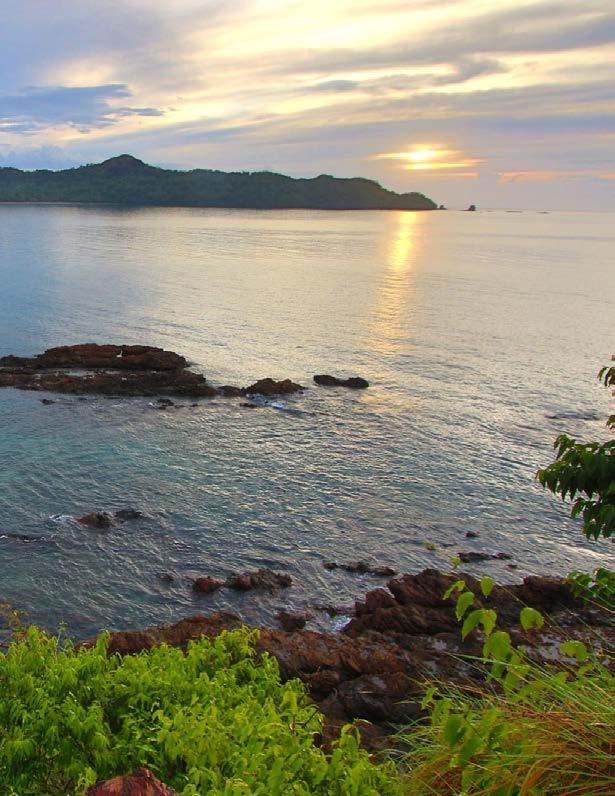
We’re number 1! To be a bit more specific, Costa Rica is home to this year’s winner on the annual “50 Best Beaches in the World” list released by EnjoyTravel.com. Epic congratulations go out to the exquisite Reserva Conchal, in Guanacaste, for achieving this amazing honor.

How did it happen that our north Pacific coastal gem should outrank 49 other sandy stretches in far-flung corners of the world? Who decides? According to EnjoyTravel.com, rankings from 1 to 50 are calculated using aggregated scores from previous media results, official Blue Flag locations and contributions from the Big 7 Travel editorial team.
“This year, you’ll notice a few old-timers alongside a whole host of newcomers, from black sandy shorelines to city beaches to castaway islands,” says the featured online results preamble. “Whether you’re in the market for a secluded sandy stretch or a buzzing beach party, you’re sure to like the look of a fair few of these beaches. Consider this your essential vacation guide.”
CLICK
BRASILITO:
• More beach photos

• Google map
• Places to eat
• Featured videos
• More stories
• Businesses
• Shops
If you’re curious about the competition, here is the complete top 50 list in countdown order. Photos and brief descriptions are posted to the EnjoyTravel.com web page.
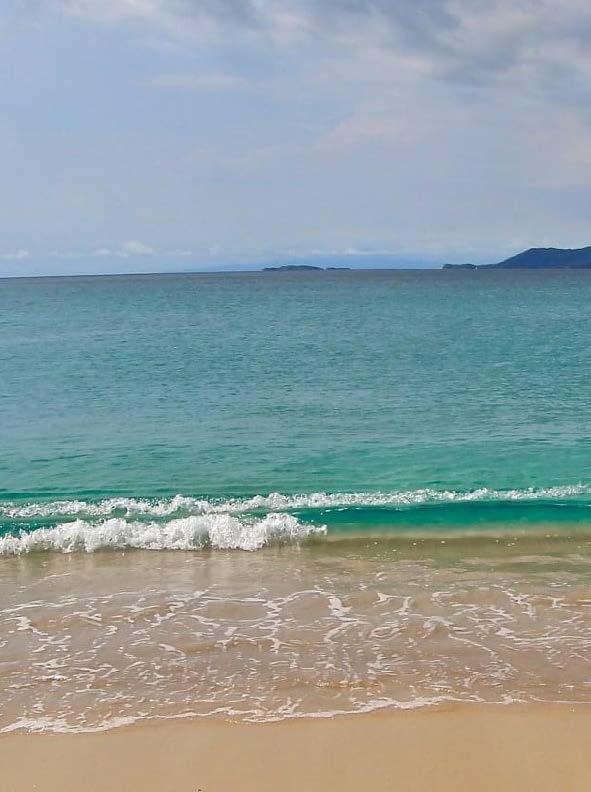
HOW MANY HAVE YOU
Tell us in the comments on the article page.
– Menorca, Spain
Protaras, Cyprus
Jamaica
– Lagos, Portugal
Sao Tome & Principe
Koh Tao, Thailand
– Anguilla
– Kauai, Hawaii
– Bermuda
Tanzania
Archipelago – Mozambique
– Goa, India
Laucala Island, Fiji
Mayo, Ireland
18. Hyams Beach – New South Wales, Australia
17. Navagio Beach (Shipwreck Cove) –Zakynthos, Greece
16. Pig Beach – Bahamas
15. Porto Santo Beach – Madeira, Portugal
14. Source d’Argent – Seychelles
13. Playa Negra – Puerto Rico

12. Zlatni rat (Golden Horn Beach) – Brac, Croatia
11. Whitehaven Beach – Whitsunday Islands, Australia
10. Reynisfjara Beach – Vík í Mýrdal, Iceland
9. Boulders Beach – South Africa
8. Pedn Vounder – Cornwall, England
CLICK HERE TO DISCOVER BRASILITO:
• More beach photos
• Google map
• Places to eat
• Featured videos
• More stories
• Businesses
• Shops
7. San Fruttuoso – Italy
6. Secret Lagoon – El Nido, Palawan, Philippines
5. Punta Mosquito – Holbox, Mexico
4. Siesta Beach – Florida, United States
3. Grace Bay – Turks and Caicos
2. Turquoise Bay – Exmouth, Australia
1. Playa Conchal – Costa Rica

Men's Softball Friday Night
Biblical Discipleship Studies, Worship and community activies for Spanish and English communities.




Adults, youth, children - come and see.
Click logo for website.
Located 2 minutes from Brasilito.
Youth
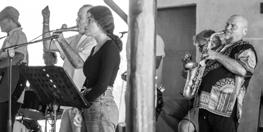
Worship
Children Community

Community Sports
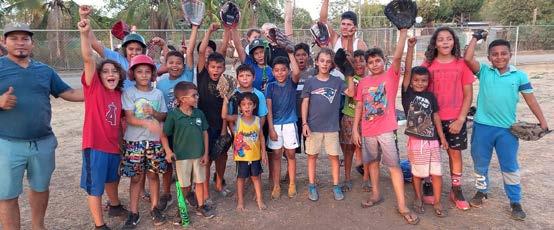


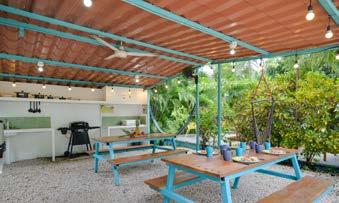


• 45 minutes from Liberia International Airport
• Brasilito, Guanacaste
• 1 km from the most beautiful beach in the region, Playa Conchal
• 10-12 restaurants and shopping within 1 km
• Built in 2006
• Ten rooms
• Turnkey operation
• Future growth is possible
Click here for more details.



Pilots from around the world gathered in Rivas, Perez Zeledon, to participate in the Open Rivas 2023 Paragliding Competition, March 4, 5 and 6. It was the fourth year the event has been held, organized by Tandem Paraglide Costa Rica, owned by Alex Badilla.



Rivas is one of the most technically difficult sites in Costa Rica, and one of the most picturesque.


Excitement was as high as Alex’s launch, which has an altitude of 1,700 meters. Rivas is one of the most technically difficult sites in Costa Rica, and one of the most picturesque, with the launch featuring a view of the iconic “cuatro pinos.” All of this makes it one of the best experiences for any paraglider pilot.
The 2023 competition drew 60 pilots from 20 international locales, including Brazil, Columbia, Tennessee, California, and even as far as Germany. Among them were some of the regulars, as well as pilots new to the Badilla family and the paragliding community.


The Tandem Paraglide operation is a family affair, and there is no shortage of talent. Alex’s wife, Wendy, helps with driving and hospitality for their clients, which include students, tandem paraglide riders and guests at their cabinas. Their two sons, Justin and Joshua are both skilled pilots and help with a fair share of the tandem rides.
CLICK LOGO FOR MORE
CLICK LOGO FOR MORE
Participants from the event.

Selling, buying, researching...contact us and experience
dreams:
Agriculture Development
Ocean Beachfront
Hotels & Houses Residential
Grupo Tropigala seeking investors/buyers of Five Beaches on 900 acres on a tropical island paradise in Costa Rica. Almost 7 kilometers of beach, power, water. Suitable for all inclusive, mid or high range development. Hour by ferry or utilize the large airfield on property. Hire our team to plan, develop and build your eco-concept.
Rock Patterson
15 years in Real estate in California, Florida and Costa Rica. 25 years in Healthcare Leadership.

Land near beach
Our Top left Casa Cielo Amazing designed house set of one of mountains José. Located privately community.


Lana Taal
29 years in Real Estate. Extensive experience in business related to the area of commercial, tourism and agricultural projects in Costa Rica, Panama and Colombia.







What is "blue zone" ?
Who is the Calypso King?
BY: many indigenous groups call home?
Who helped settle Monteverde in 1951?



QCOSTARICA - 2/14/23 – The Guanacaste Airport began an information campaign to raise awareness among tourists who visit the country’s beaches, so that they do not take home the seashells as ‘souvenirs’.

Between 2021 and 2002, airport police seized some 2 tons of seashells (conchas in Spanish) at the air terminal.
But it is not only tourists that do damage to the marine ecosystems
César Jaramillo, General Manager of the Guanacaste Airport, said that this practice has a negative environmental impact on the beaches, which is why national tourists are also part of the awareness campaign.
For this they created a new mascot, “Lora”, a female turtle known as “Lora o Verde” that seeks to protect the coasts of Guanacaste.
Through the “Be a shell hero” (Sé un héroe de las conchas) campaign, Lora has the environmental mission of educating tourists and avoiding serious damage to marine ecosystems.
“We want our passengers to fall in love with the destination and return later with their children and, above all, to protect the resources of our coasts,” said the manager of the Guanacaste Airport.
Jaramillo commented that while airport officials continue monitoring the situation, the goal is for the seizure to decrease in the coming months.
Messages that generate awareness among tourists can be seen on the airport networks.
Guanacaste received 1,443, 862 passengers in 2022; that is an increase of 43% more visitations than in 2021.

Read more about Lora, click here.




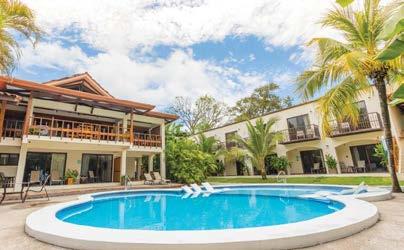



For Ticos, the term "pura vida" is an expression of happiness, optimism, and living life to the fullest. It is impossible to visit Costa Rica without hearing this phrase continuously.

1. Gringo Gardners in Costa Rica
2. Our New War Against Whaling
3. Vasomotor Rhinitis
4. Tico Expressions
Other popular articles:
• Assisting the Locals Understand Expats
• The Expat Dementia Dilemma in Costa Rica
• Aquatic ApesLiving a Biocentric Life
• Spanish: Real Estate Terms
• Peptic Ulcer Disease Solutions to the 28 Cons
• Health Tips for Hot Tub Enjoyment
• Fiercely Feminine
• Wisdom from Albert Einstein
• Costa Rica Takes Top Recognition in Coffee International Challenge
• Medical Conditions for Air Travel
• Cookware Awareness: The Trouble with Teflon
• Contact Dermatitis
• Properly Cleaning Your tongue
• What You Eat Has the Power of What You Can Achieve
See all Pura Vida articles which are translatable into 12 different languages, top 4:
For months or years, people suffer from what appears to be hay fever (allergic rhinitis). The stuffy nose, postnasal drip, sinus congestion, occasional sore throat and cough seem identical to the symptoms suffered by relatives, neighbors, or co-workers. Patients finally seek an allergy evaluation for the symptoms, only to be told after an examination and tests they don’t have allergic rhinitis at all, but a condition called vasomotor rhinitis (VMR).

VMR is a disorder of the linings of the nose, throat, and sinuses. Medical science still knows little about this disorder except that it is an abnormality of the control of blood flow to the sensitive areas.
Medical science knows more about allergic rhinitis than about VMR. The allergic variety of rhinitis is a condition in which the body’s protective system overproduces the substance IGE. This overproduction is an inherited trait of allergy sufferers. IGE identifies many common substances (such as foods, dust, and ragweed) as foreign “invaders” in the body and engages them in violent chemical battles. During these episodes the victim suffers the classical symptoms of allergy.
Detection of allergic rhinitis has been made possible by the development of blood and skin tests. If blood tests reveal no abnormal elevation of IGE (the hallmark of allergic disease), and skin tests are negative, the diagnosis is probably VMR.

Sufferers of VMR often report that their symptoms occur year-round and are made worse by small fluctuations in temperature. Another sign of VMR is nasal stuffiness that alternates from one nostril to the other, especially with changes in head position. The physician must consider all of these factors about the nature of the rhinitis before making a definitive diagnosis.
There is no cure for VMR but there are a few methods for controlling the severity of the symptoms. A physician may prescribe a nasal decongestant spray, a nasal cortisone spray or oral medications (decongestants) for use when symptoms are particularly bothersome. Allergy injections are no help for VMR patients. These injections work by creating antibodies to block the effects of IGE. Since VMR has nothing to do with IGE, allergy shots are an inappropriate treatment, not to mention a waste of valuable time and money.
It should also be noted that the chronic use of over-thecounter nasal sprays can lead to persistent swelling and stuffiness of nasal membranes. This condition, called rhinitis medicamentosa requires special treatment.

Some environmental control measures may relieve the symptoms of vasomotor rhinitis. One should avoid powders, sprays, perfumes, tobacco smoke, air conditioning and excessive household heat, in addition to those familiar plug-ins which spew chemicals into the air. Never put the thermostat over 65° during the winter. Hot dry air is very unhealthy.
Frustrations, “nerves,” and persistent stress are also contributors to VMR. Although not able to alter the environment, a healthcare provider can appreciate the frustration caused by vasomotor rhinitis and is available to answer questions and treat this disorder.
Allergy injections are no help for VMR patients.
It has been 10 years since I have commanded the helm of a ship. That was in 2013, in the Southern Ocean Whale Sanctuary with Operation Zero Tolerance, when we prevented the Japanese whaling fleet from killing 90% of its quota of minke whales.

It was my last high seas campaign. Not by choice but by circumstances.
At the conclusion of the campaign I was forced into exile in the South Pacific because Japan had issued an Interpol Red Notice for my arrest on the charge of conspiracy to trespass on a whaling ship.

I had never set foot on a Japanese whaling ship, but in 2011, a man named Peter Bethune boarded a harpoon vessel and was arrested for trespassing. I specifically told him not to board the vessel but he ignored me and did so anyway.
The harpoon ship immediately returned to Japan and Bethune was locked up to await a trial. What he did however was cowardly. He made a deal with the prosecutor. In return for signing a statement declaring that I had ordered him to board the vessel, he was given a suspended sentence. He was released and returned to New Zealand and I was officially charged with conspiracy to trespass.
I am the only person in the history of Interpol Red Notices cited for trespassing.
I spent six months on deserted islands in the South Pacific until my lawyers convinced Bethune to sign an affidavit declaring he had lied in exchange for the suspended sentence. With that affidavit, then-U.S. Secretary of State John Kerry gave me clearance to return to the United States and the government of France also gave me clearance to enter France. Japan, however, refused to recognize Bethune’s affidavit and refused to drop the Interpol Red Notice against me.
The Interpol Red Notice is used to capture serial killers, war criminals, major drug traffickers and terrorists. I am the only person in the history of Interpol Red Notices cited for trespassing.

With an Interpol Red Notice over my head it was too risky to travel and I was forced to become landbound. Although I could coordinate campaigns and ship operations I could not physically participate.
I initiated the campaigns to protect the endangered vaquita in Mexico, to oppose invasive salmon farms in western Canada, to remove marine debris from Cocos Island and to oppose Icelandic whaling.

My inability to work in the field allowed others to gain more control over campaigns and operations. I encouraged Sea Shepherd to become a movement of independent national entities, and I encouraged others to become leaders and decision-makers.
We decentralized Sea Shepherd in 2013 to allow for some leaders to initiate campaigns completely independent of myself. This allowed Sea Shepherd France to become incredibly active in protecting sharks at LaReunion Island, turtles at Mayotte Island, and dolphins being killed by the French trawler fleet. It allowed Sea Shepherd UK to organize the opposition to the killing of pilot whales and dolphins in the Faroe Islands and to organize an extensive campaign to remove ghost nets from British waters. It allowed Sea Shepherd Brazil to launch a campaign to protect Amazon River dolphins.
For the rest of the story, click here:
Hola from Gringo Gardeners in Costa Rica! We’re a Facebook group with over 5,000 members, dedicated entirely to gardening successes and challenges in this wonderfully diverse country that we live in. I started the group eight years ago, after I moved from growing zone 2 in Canada to zone 13 in Costa Rica and found my gardening knowledge doing more harm than good. I needed help! It started with a few of us, exchanging knowledge, asking questions, becoming friends and building community. I never expected the group to grow to what it is now.
Growing conditions are extremely diverse in Costa Rica because of the many micro-climates. Each area of Costa Rica has its own gardening challenges to consider. Instead of four seasons we have two — dry and rainy. A problem solved for one member of our group might not work for another a mere 20 kilometers away.
When I moved to Quepos/Manuel Antonio from Saskatoon, Canada, finicky houseplants suddenly became thriving weeds that grew in ditches. Alocasia (elephant’s ear), anthurium, caladium, philodendron, dieffenbachia, canna lily, monstera, schefflera (umbrella plant) and dracaena were everywhere. The land of petunias and marigolds was left behind and there were so many new and exciting things to try.

Gardening in a new location is all about experimenting and gathering knowledge wherever you can find it. If you absolutely must recreate what you had before, keep in mind that Costa Rica has regulations regarding the importation of seeds and plants. Permits are required for good reason — we’ve all heard stories of a non-native species taking over with devastating results to the ecosystem.
There are some plants that will thrive pretty much anywhere in the country. Consider croton, which provides a wide range of colorful striped and mottled green, red and yellow foliage. Another favorite is sansevieria (snake plant), which is virtually indestructible. I like to cut off a few leaves at the base and stick them in a vase with water. Not only are they a great filler for floral arrangements, they’ll develop roots and you can replant them outside. Many plants here follow the “stick it in the ground and it will grow” premise.
Shannon recommends vetiver grass for slopes that need erosion control. It’s beautiful and functional at the same time. I like peanut grass (mani) which is also common as a ground cover. The small yellow blooms are an added bonus — just look out for the neighbor’s cows, who would be more than happy to wander over and sample it.

Shannon also favors ixoras (jungle geranium) for a low maintenance, blooming hedge or border. Hibiscus works well as a slightly higher and more dense hedge or privacy screen and the blooms are lovely.



Nel, in San José, can’t say enough about spider plants, wandering jew and butterfly bushes, which grow pretty much anywhere. Her favorite is juanilama (lemon verbena). In her words, “you can't kill those things.” Her perennial herb garden includes basil, rosemary, thyme, parsley (both Italian and curly), tarragon, thyme, verbena and mint.

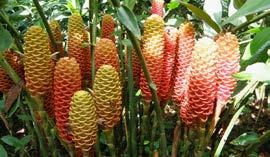
There are some plants that will thrive pretty much anywhere in the country.Mr. Prick, our mascot Ginger
agarrado — cheapskate, miserly.
agüevado — bored, bummed out, sad, dissatisfied, driven to distraction.
agüevazón — a situation that makes you feel agüevado, like waiting in line at the bank for two hours: ¡Qué agüevazón!
A eso voy — “That’s what I’m getting at,” “That’s what I’m saying.”
agarrar de maje — to trick someone. Me dijo que su hermana era bonita, pero me agarró de maje porque no tiene hermana. — “He told me his sister was pretty, but he tricked me because he doesn’t have a sister.”
al chile — literally “to the chile.” Usually this means fast, right now, right away, but it’s also used to mean “really.” ¿Al chile? — really? ¡Al chile! — really!
al final de cuentas — “at the end of the day,” in summation, to sum it all up, end of story.
arroz con mango — literally “rice with mango,” this means a tangle, a mess, un enredo.
bulla — noise, racket, uproar. Los vecinos estaban haciendo bulla hasta las 3 de la mañana — “The neighbors were making a racket until 3 a.m.”
chiva — cool, neat, great. Qué chiva — “How cool.”
chunche — thingamajig, whatchamallit, any little object you don’t know
comehuevos — egg eaters. Refers families who take cheap vacations bringing boiled eggs to eat so restaurants.
descarado — someone with no care what anyone thinks about person, un sinvergüenza.

desmadre — a chaotic disaster,
despiche — same as desmadre ¡Güácala! — Yuck!
hediondo — stinky.
le patina el coco — literally “her/his this means someone is crazy.
madrear — to insult someone
manda huevo — literally “send easy, just do it, what’s the problem?” dólares y quieres comprar un huevo! — “You have $10,000 used car? Just do it!”
whatchamallit, a word used for know the name of.
Refers to frugal Costa Rican vacations on the beach, so they don’t have to pay for no scruples who doesn’t about him; a shameless disaster, a mess.
desmadre, but more vulgar.
“her/his head is skating,” crazy.
someone else in a vulgar fashion. “send egg,” this means, “It’s problem?” Tienes 10 mil un carro usado? ¡Manda and you want to buy a

me extraña — “I’m surprised.” Sometimes used sarcastically to mean “Obviously,” as when something expected happens and you’re not really surprised.
me pega el ombligo a la espalda — “My navel is sticking to my back,” meaning, “I’m hungry.”
meter la pata — literally “to stick your foot in it,” this means to screw something up. Ya metió las patas means a woman has gotten pregnant by accident.
miserable — cheapskate, miserly.
nada que ver — Literally “nothing to see,” this means that one thing has nothing to do with another thing, but it’s often used to mean, “No way,” “That’s wrong,” “That’s BS.” Este vino está en descuento, y todavía cuesta 20 mil? Nada que ver. — “This wine is on sale, and it still costs 20,000? That’s BS.”
por dicha — Luckily, thank goodness. An unreligious way of saying Gracias a Dios, “Thank God.”
Qué pereza — What laziness. An expression used when you’re feeling lazy and don’t feel like doing anything.
sinvergüenza — a shameless person, un descarado. tacaño — tightwad, cheapskate.
¡Ufa! — Expression used when something smells back, like when you smell a skunk.

Brought to you by Deals in Costa Rica
One of the beautiful aspects of Costa Rica is the variety of opportunities for adventures. Literally there is something for everyone. The extremes are real, from being lazy chillin’ in a hammock by the beach to trekkin' a volcano trail to adrenaline rush jumps.
Deals in Costa Rica presents a small fraction of the adventures that await your next vacation/escape. We highlight examples in just five regions to intrigue your adventuresome spirit. Click on the buttons for more information.


There are two major international airports. Check to see which one is nearest your desired locations to visit.
Sun Real Estate specializes in the Guanacaste Real Estate Market.

We have a significant amount of unique Mountain Real Estate, Beach Properties or just beautiful Farm Land to offer.

As an independent Real Estate Broker, our experts cover a variety of locations ideal for living, retiring or investing in Guanacaste.
Hot Springs and Mountain Farms, such as Residential and Building lots, Commercial Land, Hotels, Titled Beachfront Farms, for development also very huge properties.
Business ideas are what Sun Real Estate listings include.

Johannes Valentin Beriè, known as Hans is a German entrepreneur and the owner of different companies, working as a proven and successful businessman, for 30 years in Costa Rica, with different kinds of views, and greatly connected everywhere, to get things done.
With Sun Real Estate he formed a team of specialists and solvers of critical situations, for any type of happenings, to lead the clients to a positive outcome.
Hans never lets his clients run alone before and after a successful closure, he always watches them and makes sure they are in a safe place.


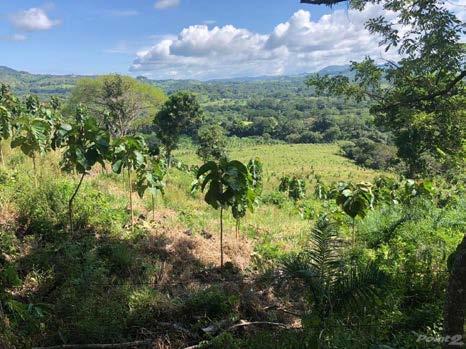



The landscape in your vicinity of Costa Rica could look different down the road as proposed legislation is being considered for a new urban and rural land use category.
The Asamblea Legistativa is studying bill number 23.200, the “Law of creating touristic residential recreational parcels.” This bill adds section 33 bis to the Urban Planification Law number 4240, to create a new form of economic reactivation and foreign and national investment attraction.
The Urban and Planification Law regulates the subdivision of land and allows each municipality to plan and control urban development in its county. Currently, there are three main district land categories under Costa Rican regulation:
1. Urban — corresponds to territories designated for the development of population centers.
2. Rural — land dedicated in its majority to the use and prioritization of natural resources, characterized by the joint evolution of society and nature.
3. Mixed — land that has more than one use: residential, commercial, industrial, or between agricultural, livestock, forest, or others.
According to the Fractionation and Urbanization Regulation, an agricultural parcel — within the third category — must have a minimum area of 5,000 square meters in rural zones and 7,000 square meters in urban zones.
Some owners have used agricultural parcels differently than they were originally intended — for agricultural use — and instead developed them for tourism or residency.
The proposed touristic residential recreational parcel category will be a unique division modality. In both urban and rural areas, such land parcels may be used for residential and recreational purposes through “touristic easement.” This legal designation will allow controlled infrastructure growth and new developments to reactivate tourism in the country.
The proposed tourist residential recreational parcel will have the following features:
• The area must be at least 5,000 square meters.
• The cadastral plan must indicate “touristic residential use.”
• More than one house can be built for residential and recreational use; buildings can have a maximum of two floors each. The maximum coverage for construction will be 25% of the parcel area.
• Access will be through an easement “servidumbre turistica” of seven meters wide in favor of and against the parcel. This easement will allow the authorities to provide public services, urbanistic control, municipal security, health services, fireman, or anything related.
• The cession of the public area will not be required.
Some owners have used agricultural parcels differently than they
Bill 23.200 will not require the approval of any additional regulation or bylaws. However, each Municipality can issue particular dispositions according to its master plans.
Minimum size
Activity or use
Type of access
Maximum coverage for construction
The main differences between these two categories of land, agricultural and touristic residential recreational parcels, are the following:
Urban: 7,000 sq.m. (inside Greater Metropolitan Area)
Rural: 5,000 square meters.
Agricultural, livestock, forest or mixed between those.
•Agricultural easement 7 m. wide
•Must have direct connection to public road
•Public services providers can use easement
Maximum coverage area 25% of parcel:
1. Only one single-family home of 300 sq.m. up to two floors
2. House for agricultural worker.
3. Infrastructure associated with agrotourism activities
These three constructions together cannot exceed 10% of parcel area. The outstanding 15% must be used in agricultural infrastructure
At least 5,000 square meters.
Touristic, residential, and recreational activities.
Touristic easement of 7 meters wide Public services providers can use the easement"
Maximum coverage area 25% of parcel:
•Multiple structures, such as houses, can be built for residency and recreation
•Maximum two floors for each building
Cease for public area: any property fractionated outside cities or urbanized zones must cease freely for green areas and urban equipment, 10% of the area.
Once the bill is approved, if no changes are made, the owners of agricultural parcels will have 24 months to turn their property into a tourist parcel by following proper due process. They must submit a written petition to the corresponding municipality requesting the land classification change. It will not be required to rectify or update the cadastral plan or the registered title before the National Registry.
We at GM Attorneys will be pleased to help you with your legal matters in Costa Rica! Please feel free to contact us at info@gmattorneyscr.com or visit our blog section at https://www.gmattorneyscr.com/gm_ website/html/blog.php
Read more legal ease articles they were originally intended.
QCOSTARICA – On Wednesday, March 8, in celebration of International Women’s Day, the Guanacaste Airport received a 100% crewed flight by female personnel.
JetBlue flight 1691 from New York’s John F. Kennedy International Airport (JFK) landed in Guanacaste (LIR) Wednesday afternoon as part of International Women’s Day.

To commemorate the day, the airport organized a welcoming ceremony to honor the crew at this important milestone in the terminal’s airport history. The crew was received by eleven girls who received an educational talk and a visit inside the plane by airline personnel.
The crew was made up of Captain Miriam Lainez and First Officer Jessica Lower, accompanied by flight attendants, Kristi Lowery, Yamilka Fernandez, Courtney Wilson, and Jennifer Kryvanick.
“It is an honor for JetBlue to celebrate International Women’s Day together with our airport partners with this flight operated exclusively by women,” said Monica Cordeiro, JetBlue’s regional manager for Latin American cities. “As an airline, we are committed to providing the tools and resources for more women to join the aviation industry and it is through events like this that we hope to inspire women and future generations.”
QCOSTARICA – Medical devices and fresh tropical pineapples were the products most exported by Costa Rica in 2022, according to the annual data on Foreign Trade from the National Institute of Statistics and Censuses (INEC).

The total value of merchandise exported exceeded US$17 billion dollars, an increase of 14.08% of the previous year, meanwhile, imports were US$24 billion dollars, an increase of 11.19% compared to 2021.
Ana Mercedes Acuña, Coordinator of the Economic Statistics Unit, explained that maritime transport represented the main means of importing and exporting goods, with 64% and 48% respectively.
The Ministra de Ciencia, Innovación, Tecnología y Telecomunicaciones (MICITT) – Ministry of Science, Innovation, Technology and Telecommunications – Paula Bogantes Zamora, attributes to her portfolio the success in attracting medical device manufacturing companies and, furthermore, as an excellent candidate to attract the pharmaceutical industry,
“(…) Costa Rica has done a formidable job attracting medical device companies. Our next frontier is to attract pharmaceutical companies and the European Union is a very important player in this field”, said Bogantes during her virtual participation in the High Level Pharmaceutical Forum of the European Union (EU) and the Community of Latin American and Caribbean States (CELAC).
















• New Obligations for Inactive Corporations
• Options for Real Estate Subdivision in Costa Rica
• New Capital Gains Tax in Costa Rica
• Corporation Basics: Benefits and Obligations
• Costa Rica Residency
• Home Luxury Tax 2022
• FAQs for Expats
• Mandatory Registration of Rental Properties for Non-Traditional Tourist Accommodations
• The Eviction Process in Costa Rica
• Advance Directives for Medical Decisions
• New Laws Provide Second Chance for Corporations Being Dissolved or Already Dissolved
• Digital Nomads: Work Remotely From the Land of Pura Vida!
• Chartering in Costa Rica for International Vessels is Allowed


